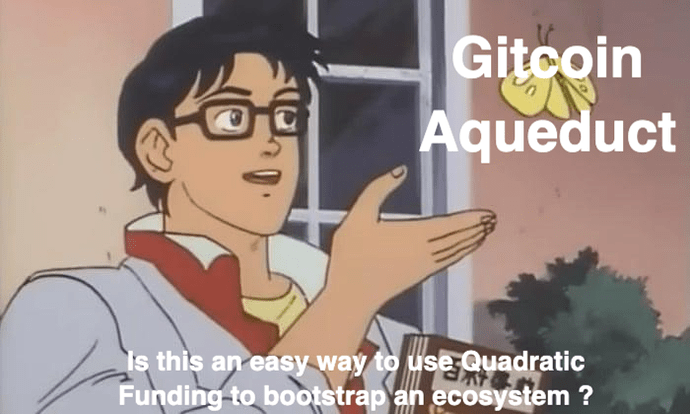Authors
Summary
This paper introduces Gitcoin Aqueduct, a tool that incentivizes ecosystem development for your project with a single line of Solidity.
Aqueduct helps unbundle the work of protocol creation from the work of supporting an ecosystem, and helps protocols grow in a truly decentralized way.
To fill your Aqueduct, you transfer in some of your project’s revenue or inflation.
In the beginning, your Aqueduct will distribute these tokens to developers on your ecosystem automatically, creating and running quadratic funding rounds with no human intervention.
As your project grows and more assets flow into its Aqueduct, GitcoinDAO will begin to provide more and more high-touch ecosystem development services.
Narrative
Problem
Alice is developing a new NFT project, NFTP. She is a talented coder and artist and believes in what she is making.
Alice also knows that if her project is to be successful long-term, it will need an ecosystem, with other developers contributing, a team managing the Discord, and so on.
However, Alice is a builder, not a manager. She is also committed to decentralization.
As a result, she doesn’t want to personally coordinate an ecosystem long-term, and she doesn’t want to set up an organization or hire somebody to do it for her.
Solution
By design, NFTP receives ongoing revenue from secondary sales of its NFTs.
Alice redirects 10% of this revenue to NFTP’s Aqueduct.
If NFTP were intended as a pure public good, it might send 100% of revenue to its Aqueduct.
Result
After a sufficient amount of tokens accrue in the Aqueduct, Gitcoin automatically holds a quadratic funding round for NFTP using those tokens: developers propose projects that will benefit the NFTP ecosystem, and members of the NFTP community allocate the Aqueduct’s funds to those projects using the quadratic funding mechanism.
GitcoinDAO supports this process both by providing the infrastructure for funding and by promoting the round on Twitter and other channels (including, perhaps, a list of Discords to which a GitcoinDAO bot has been invited). Critically, none of this requires any significant expense or human time.
Furthermore, it requires no further interaction from Alice or NFTP, which doesn’t even need to have governance.
As NFTP grows, aided by Aqueduct-funded development, the amount of revenue allocated to the Aqueduct will grow as well, eventually reaching a point where human involvement is both prudent and economical.
Accordingly, at certain pre-defined revenue tiers, the level of service provided by GitcoinDAO will increase.
For example, a $100K Aqueduct might come with automated human-in-the-loop anti-fraud support, while a $1M Aqueduct might come with a part-time community manager, and a $10M Aqueduct might come with a full-time ecosystem management team.
GitcoinDAO would be compensated with a percentage fee for providing these services.
Mechanism Notes
Side Round Protection
The main challenge with this design is how to ensure that funds in the NFTP side-round are actually spent on NFTP ecosystem projects.
At sufficient levels of Aqueduct funding, a fee to GitcoinDAO could easily pay for humans to help ensure grants are appropriate.
For smaller rounds, or even to ensure alignment in larger rounds, specific protection mechanisms might help. For example, in order to match a donation of 1 ETH, Aqueduct might require the donor to stake at least 5 ETH worth of NFTP NFTs for some time period.
Or, it might require the person posting a new grant to post a bond that can be slashed if they are found to have submitted a project that isn’t for the benefit of NFTP, with the bond amount sufficient to incentivize both reporting and adjudication.
Alternatives to Quadratic Funding
Today, quadratic funding is the leading system for permissionless ecosystem development.
Over time, other methods like Retroactive Public Goods Funding might prove to be more effective.
Any such method can easily integrate with Aqueduct.
Conclusion
Gitcoin Aqueduct unbundles the work of designing and implementing a protocol from the work of scaling it and managing its community.
By doing so, it reduces the friction involved with starting a protocol while providing opportunities for developers to make a living contributing to open source.
This is only a rough design sketch, and there are likely many problems to be solved before it can become a reality.
We’re excited to hear your feedback and work on improving it together.
Acknowledgements
Dan Robinson, llllvvuu, Allan Niemerg, Jordan Lazaro, Greg Fodor
